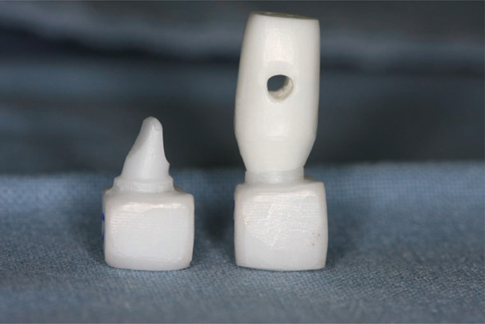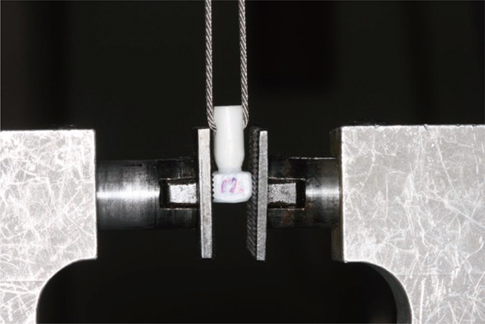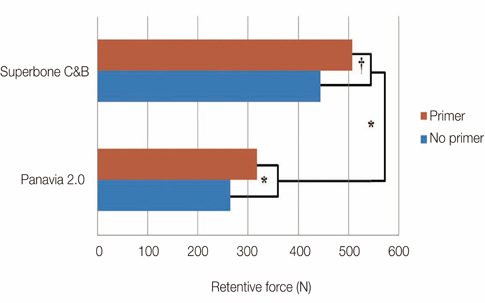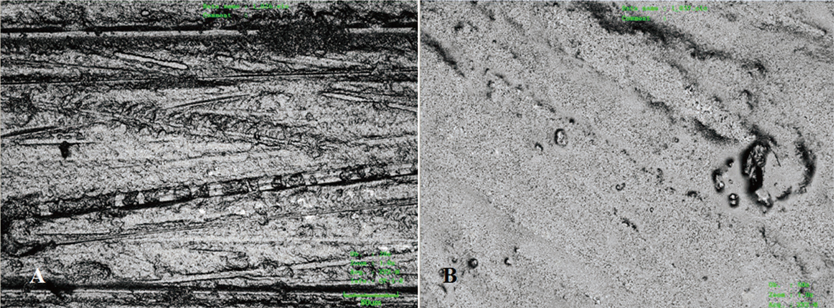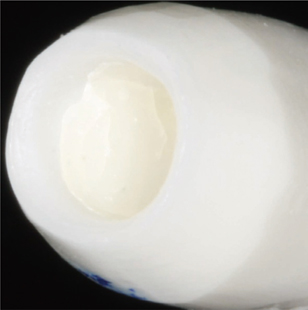J Adv Prosthodont.
2013 May;5(2):198-203. 10.4047/jap.2013.5.2.198.
The effect of resin cements and primer on retentive force of zirconia copings bonded to zirconia abutments with insufficient retention
- Affiliations
-
- 1Department of Dentistry, School of Medicine Inha University, Incheon, Republic of Korea. onsdo@inha.ac.kr
- 2Energy & Environmental Division, Korea Institute of Ceramic Engineering and Technology (KICET), Seoul, Republic of Korea.
- KMID: 2284761
- DOI: http://doi.org/10.4047/jap.2013.5.2.198
Abstract
- PURPOSE
The purpose of this study was to investigate the effect of resin cements and primer on the retentive force of zirconia copings bonded to zirconia abutments with insufficient retention.
MATERIALS AND METHODS
Zirconia blocks (Lava, 3M ESPE, St. Paul, MN, USA) were obtained and forty sets of zirconia abutments and copings were fabricated using CAD/CAM technology. They were grouped into 4 categories as follows, depending on the types of resin cements used, and whether the primer is applied or not:Panavia F2.0 (P), Panavia F2.0 using Primer (PRIME Plus, Bisco Inc, Schaumburg, IL, USA) (PZ), Superbond C&B (S), and Superbond C&B using Primer (SZ). For each of the groups, the cementation was conducted. The specimens were kept in sterilized water (37degrees C) for 24 hours. Retentive forces were tested and measured, and a statistical analysis was carried out. The nature of failure was recorded.
RESULTS
The means and standard deviations of retentive force in Newton for each group were 265.15 +/- 35.04 N (P), 318.21 +/- 22.24 N (PZ), 445.13 +/- 78.54 N (S) and 508.21 +/- 79.48 N (SZ). Superbond C&B groups (S & SZ) showed significantly higher retentive force than Panavia F2.0 groups (P & PZ). In Panavia F2.0 groups, the use of primer was found to contribute to the increase of retentive force. On the other hand, in Superbond C&B groups, the use of primer did not influence the retention forces. Adhesive failure was observed in all groups.
CONCLUSION
This study suggests that cementation of the zirconia abutments and zirconia copings with Superbond C&B have a higher retentive force than Panavia F2.0. When using Panavia F2.0, the use of primer increases the retentive force.
MeSH Terms
Figure
Reference
-
1. Anusavice KJ. Recent developments in restorative dental ceramics. J Am Dent Assoc. 1993; 124:72–74. 76–78. 80–84.2. Kelly JR, Nishimura I, Campbell SD. Ceramics in dentistry: historical roots and current perspectives. J Prosthet Dent. 1996; 75:18–32.3. Blatz MB, Chiche G, Holst S, Sadan A. Influence of surface treatment and simulated aging on bond strengths of luting agents to zirconia. Quintessence Int. 2007; 38:745–753.4. Luthardt RG, Holzhüter M, Sandkuhl O, Herold V, Schnapp JD, Kuhlisch E, Walter M. Reliability and properties of ground Y-TZP-zirconia ceramics. J Dent Res. 2002; 81:487–491.5. Yildirim M, Edelhoff D, Hanisch O, Spiekermann H. Ceramic abutments-a new era in achieving optimal esthetics in implant dentistry. Int J Periodontics Restorative Dent. 2000; 20:81–91.6. Ozcan M, Vallittu PK. Effect of surface conditioning methods on the bond strength of luting cement to ceramics. Dent Mater. 2003; 19:725–731.7. Zhang Y, Lawn BR, Malament KA, Van Thompson P, Rekow ED. Damage accumulation and fatigue life of particle-abraded ceramics. Int J Prosthodont. 2006; 19:442–448.8. Zhang Y, Lawn BR, Rekow ED, Thompson VP. Effect of sandblasting on the long-term performance of dental ceramics. J Biomed Mater Res B Appl Biomater. 2004; 71:381–386.9. Bottino MA, Valandro LF, Scotti R, Buso L. Effect of surface treatments on the resin bond to zirconium-based ceramic. Int J Prosthodont. 2005; 18:60–65.10. Dérand P, Dérand T. Bond strength of luting cements to zirconium oxide ceramics. Int J Prosthodont. 2000; 13:131–135.11. Kern M, Wegner SM. Bonding to zirconia ceramic: adhesion methods and their durability. Dent Mater. 1998; 14:64–71.12. Emms M, Tredwin CJ, Setchell DJ, Moles DR. The effects of abutment wall height, platform size, and screw access channel filling method on resistance to dislodgement of cement-retained, implant-supported restorations. J Prosthodont. 2007; 16:3–9.13. Janda R, Roulet JF, Wulf M, Tiller HJ. A new adhesive technology for all-ceramics. Dent Mater. 2003; 19:567–573.14. Lüthy H, Loeffel O, Hammerle CH. Effect of thermocycling on bond strength of luting cements to zirconia ceramic. Dent Mater. 2006; 22:195–200.15. Blatz MB, Sadan A, Martin J, Lang B. In vitro evaluation of shear bond strengths of resin to densely-sintered high-purity zirconium-oxide ceramic after long-term storage and thermal cycling. J Prosthet Dent. 2004; 91:356–362.16. Atsu SS, Kilicarslan MA, Kucukesmen HC, Aka PS. Effect of zirconium-oxide ceramic surface treatments on the bond strength to adhesive resin. J Prosthet Dent. 2006; 95:430–436.17. Ozcan M, Nijhuis H, Valandro LF. Effect of various surface conditioning methods on the adhesion of dual-cure resin cement with MDP functional monomer to zirconia after thermal aging. Dent Mater J. 2008; 27:99–104.18. Wegner SM, Kern M. Long-term resin bond strength to zirconia ceramic. J Adhes Dent. 2000; 2:139–147.19. Ernst CP, Cohnen U, Stender E, Willershausen B. In vitro retentive strength of zirconium oxide ceramic crowns using different luting agents. J Prosthet Dent. 2005; 93:551–558.20. Lee HJ, Ryu JJ, Shin SW, Suh KW. Effect of surface treatment methods on the shear bond strength of resin cement to zirconia ceramic. J Korean Acad Prosthodont. 2007; 45:743–752.21. Kim CH, Jeon YC, Jeong CM, Lim JS. Effect of surface treatments of zirconia ceramic on the bond strength of resin cements. J Korean Acad Prosthodont. 2004; 42:386–396.22. Lindgren J, Smeds J, Sjögren G. Effect of surface treatments and aging in water on bond strength to zirconia. Oper Dent. 2008; 33:675–681.23. Lee JH, Kim HS, Pae AR, Woo YH. Influence of sandblasting and primer on shear bond strength of resin cement to zirconia. J Korean Acad Prosthodont. 2011; 49:49–56.24. Magne P, Paranhos MP, Burnett LH Jr. New zirconia primer improves bond strength of resin-based cements. Dent Mater. 2010; 26:345–352.25. Michalakis KX, Hirayama H, Garefis PD. Cement-retained versus screw-retained implant restorations: a critical review. Int J Oral Maxillofac Implants. 2003; 18:719–728.26. Abbo B, Razzoog ME, Vivas J, Sierraalta M. Resistance to dislodgement of zirconia copings cemented onto titanium abutments of different heights. J Prosthet Dent. 2008; 99:25–29.27. Ramp MH, Dixon DL, Ramp LC, Breeding LC, Barber LL. Tensile bond strengths of provisional luting agents used with an implant system. J Prosthet Dent. 1999; 81:510–514.28. Covey DA, Kent DK, St Germain HA Jr, Koka S. Effects of abutment size and luting cement type on the uniaxial retention force of implant-supported crowns. J Prosthet Dent. 2000; 83:344–348.29. Squier RS, Agar JR, Duncan JP, Taylor TD. Retentiveness of dental cements used with metallic implant components. Int J Oral Maxillofac Implants. 2001; 16:793–798.30. Mansour A, Ercoli C, Graser G, Tallents R, Moss M. Comparative evaluation of casting retention using the ITI solid abutment with six cements. Clin Oral Implants Res. 2002; 13:343–348.31. Ebert A, Hedderich J, Kern M. Retention of zirconia ceramic copings bonded to titanium abutments. Int J Oral Maxillofac Implants. 2007; 22:921–927.32. Thompson JY, Stoner BR, Piascik JR, Smith R. Adhesion/cementation to zirconia and other non-silicate ceramics: where are we now? Dent Mater. 2011; 27:71–82.33. Behr M, Proff P, Kolbeck C, Langrieger S, Kunze J, Handel G, Rosentritt M. The bond strength of the resin-to-zirconia interface using different bonding concepts. J Mech Behav Biomed Mater. 2011; 4:2–8.
- Full Text Links
- Actions
-
Cited
- CITED
-
- Close
- Share
- Similar articles
-
- Resin bonding of metal brackets to glazed zirconia with a porcelain primer
- Influence of sandblasting and primer on shear bond strength of resin cement to zirconia
- Effects of abutment diameter, luting agent type, and re-cementation on the retention of implant-supported CAD/CAM metal copings over short abutments
- Evaluation of removal forces of implant-supported zirconia copings depending on abutment geometry, luting agent and cleaning method during re-cementation
- Microhardness of resin cements after light activation through various translucencies of monolithic zirconia

